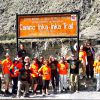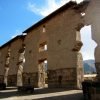Machu Picchu Tours — What most people lose when visiting Machu Picchu?
Machu Picchu stands high above the Sacred Valley in the Cusco Region of Peru. Constructed during the height of the Inca Empire, this landscape of rock and stone is a place that is both magical and timeless. This mysterious and intriguing site is surrounded by mounds of emerald earth and dramatic peaks. With every step you take over the sacred ground here, you’ll marvel at Andean peaks that resemble skyscrapers carved from Mother Nature’s careful hand. Visitors from all over the globe come here to explore an empire built by the Incas sometime around the year 1450. It may surprise you to know that this iconic and historically significant site remained virtually undiscovered by the rest of the world until it was found by a young Yale lecturer in 1911. It wasn’t long before archaeologists and tourists began journeying to the Andes Mountains to enjoy Machu Picchu tours.
Already a UNESCO World Heritage Site since 1983, Machu Picchu was declared one of the New Seven Wonders of the World by voters in 2007. If you’re planning a Machu Picchu vacation, it is important to make sure you don’t skip some of the best treasures that await you here. Many people simply visit the site’s main citadel and skip the other treasures and trails that take a bit more work to find. In fact, a large portion of the one million people who visit this year won’t get to see some of the most stunning caves, trails, and temples here because they will only stay a few hours for a short and unsatisfying day trip. As you plan you’re itinerary in Peru, take a look at the top five attractions you simply must make time to visit during your adventure at Machu Picchu.
Huayna Picchu Mountain
The enchanted Urubamba River bends around this celebrated Peruvian mountain peak. Guides will tell you that this mountain’s peak was the residence of Incan high priests. Temple of the Moon (more on that later) happens to be nestled into the side of Huayna Picchu Mountain. It is extremely important to plan your trip here ahead of time since admittance to Huayna Picchu Mountain is limited to 400 visitors per day. The climb to the top takes about an hour. You will enjoy a hike through a steep path that takes you through natural caves. There are steel cables to offer support at some of the more slippery points along the path.




The Temple of the Moon
The Temple of the Moon is the jewel in the crown of all Machu Picchu tours. You will need to wake up early if you want the privilege of visiting the Temple of the Moon. The first 400 people who arrive at the park’s entry gate every morning are the only ones admitted inside for the day. For those who do make it to Temple of the Moon. They are treated to views of some of the most impressive stonework on the entire campus. This ceremonial temple on Huayna Picchu contains a brilliant throne carved from rock. The artwork in the temple depicts the heavens, the earth, and the underworld. The Temple of the Moon is comprised of three parts:
- An overhanging cave etched with intricate stonework
- A towering double-jamb doorway
- A grouping of structures
While the Inca’s purpose for constructing the Temple of the Moon is unclear to historians. It is known that caves were often thought to be the entrance points for gods. It is highly likely that the temple was used for worship. Some historians believe that the temple may have been a place for royal burials, sacrifices or ritual bathing.



Visiting Machu Picchu Mountain
Machu Picchu Mountain is perhaps the most overlooked opportunity for splendor at Machu Picchu. At more than 10,000 feet above sea level, this amazing mountain offers unspoiled views of Incan ruins and natural scenery that create one of the best opportunities for Machu Picchu hiking tours. When you reach the summit, you will stand in the spot where Inca priests once performed sacred rituals. You will need to provide your passport and ticket at an entrance hut before you are permitted to walk the trail.
You can expect to gain altitude quite steadily once you pass the agricultural terraces and warden huts that signal the start of your journey. The steps you take will become steeper and narrower as you approach the base of Machu Picchu Mountain. The trial is considered to be moderate to challenging. Factors like rain or fog can make the trek more challenging during certain times of the year.



Sun Gate or Inti Punku
The Sun Gate (Inti Punku) was once the formal entrance to Machu Picchu. You should definitely make a visit to this enchanted, sacred spot part of your upcoming Machu Picchu vacation. Hiking the trail that leads to the Sun Gate will take you on a windy and enchanted journey that includes agricultural terraces and tall peaks. To hike the complete trail should take you between three and four hours. Of course, setting your eyes on a set of tall stone columns that once welcomed visitors from other lands is more than worth the effort. You will also be treated to incredible views from that altitude.
The Sun Gate’s remote location is believed to have been chosen by the Inca because the spot was only intended to welcome elite visitors. It is known that special guards used the Sun Gate to control who was permitted to enter Machu Picchu. The Sun Gate is accessible throughout the year. Many people embark on treks early in the morning in order to enjoy cooler temperatures and natural shade. Some helpful things to pack for your trek include:
- A lightweight raincoat or poncho
- Sun protection
- Comfortable sneakers or hiking boots



Visiting Machu Picchu Inca Bridge
Are you looking for Machu Picchu hiking tours that will take your breath away? Trekking to the Inca Bridge is one of the more adventurous things you can do during your visit to Machu Picchu. What is especially magnificent about this trail is that it will bring you through a tropical rain forest that’s teeming with wildflowers and wildlife.
Of course, your heart is sure to leap a little in your chest when you peer down over the path’s ridge to enjoy views of a valley that stands 1,900 feet below you. You will never forget the awe and serenity of listening to a rushing river below you. As you breathe in clear, pure Andean air. The entire trial can be experienced in about 40 minutes. You will not require a ticket to explore this gorgeous portion of Machu Picchu. The trail is open any time during regular hours of operation.





















